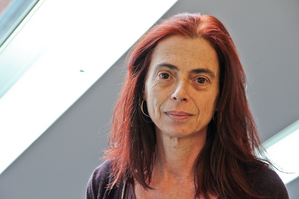Dr. Marie Bels
Curriculum Vitae
Marie Bels studierte Geografie an der Université Louis Pasteur de Strasbourg, Frankreich, und erlangte anschließend die laurea in architettura am Istituto Universitario di Architettura di Venezia (IUAV)], Italien. 2013 wurde sie an der Ecole Nationale d’Architecture Paris Malaquais / Université Paris Est mit einer Dissertation mit dem Titel „Les grands projets de la justice française. Stratégies et réalisations du ministère de la justice (1991-2001)“ promoviert. Dr. Bels lehrte unter anderem an den Architekturhochschulen Paris-Belleville, Paris-Malaquais und Marseille-Luminy. Zudem arbeitete sie als unabhängige Wissenschaftlerin für Architekturbüros, Firmen und Gemeinden. In den 1990er Jahren wurde sie vom französischen Justizministerium mit einer Studie über die architektonische Gestalt des Rechts beauftragt, welche die Grundlage einer Reihe von Architekturwettbewerben für neue Gerichtsgebäude bildete. Dr. Bels arbeitet zudem als Übersetzerin italienischer Architekturbücher ins Französische. Von Januar bis August 2014 hatte sie eine Postdoktorandenstelle am Laboratoire d’étude de l’architecture potentielle (LEAP) der Université de Montréal inne. In ihren Forschungsarbeiten untersucht sie die Natur öffentlicher Architektur in demokratischen Kontexten, indem sie demokratische Institutionen auf ihre räumlichen und symbolischen Elemente hin befragt und ihr Verhältnis zur zeitgenössischen Stadt, Stadtgeschichte und kollektiver Erinnerung analysiert. Von Januar bis September 2015 war Marie Bels Fellow am Käte Hamburger Kolleg „Recht als Kultur“.
Forschungsprojekt
Contemporary Courthouse Architecture: Between Normativity and Spectacularity
Of all the arts, architecture is the most complex and paradoxical, being the art of building forms and spaces that must be at the same time useful and representative. Furthermore, a construction mobilizes the material and intellectual energies of so many people over such a long course of time that we may consider the results, beyond the work of design teams, as a collective product of a social group. In the case of public architecture, it can reveal, as a mirror, how an entire society seeks to represent itself.
New courthouses recently built in Europe have completely broken with the traditional judicial typology. Designed by leading European architects, they are very spectacular in their forms, dimensions and materials, making frequent use of formal transgressions and stage effects. In doing so, they seem to be participating in an image battle heightened by the high media exposure of architecture on a worldwide level.
How does courthouse architecture express the monumentality demanded by the judiciary and politicians as representing an integral part of the judge's role and the status of the institution in an urban space? And what does this say about law and justice in contemporary society?
Furthermore, judicial institutions now face functional requirements that aim to improve performance and quality. This results in a high functionality and flexibility of working spaces, which in turn induces very normative compositional schemes. The architectural results are at the very least paradoxical and thus directly question the didactic power of architectural language, especially as there is no longer one official style or aesthetic principle in the architectural world.
I have been studying this phenomenon since it began in France, in the 1990s, with a series of competitions promoted by the French Department of Justice. During my fellowship, I will continue to integrate the most recent and relevant European architectural experiences into my research. By means of a comparative global analysis of architectural composition and courthouse typologies, I intend to develop accurate tools of knowledge suited for studying the relationships between architecture and justice in a democratic society. Public architecture has a political function, both in the city and in the collective imagination – in particular when it comes to judicial buildings that host funding institutions. If, as I think, a new paradigm in courthouse architecture is now emerging, it may mean that the meaning and the role of law has also changed profoundly. This research will form a central part of a theoretical essay about the architectural image of justice in a multicultural and globalized context.
Publikationen (Auswahl)
- Sur les traces de Ledoux, Marseille: Editions Parenthèses 2004, 190 S. (Eine Besprechung der architektonischen, urbanen und institutionellen Konstruktionsgeschichte des Gerichtsgebäudes und der Gefängnisse von Aix-en-Provence, von 1784 bis 1997.)
- Le tribunal de grande instance de Bordeaux, in: Architecture Créé, Nr. 284, Februar 1998, S. 71-78.
- Autour du Palais. L’histoire en chantier, Exhibition Journées du patrimoine 1997, Palais de Justice d’Aix-en-Provence: Association pour la Restauration et la Sauvegarde du Patrimoine Aixois (ARPA), Ministère de la Justice, Ministère de la Culture, 1997.
- Questions d’image, in: Revue des Monuments Historiques, Nr. 200, Februar 1996, S. 42-45.
- Beau comme l’antique, l’art de Penchaud, in: Revue des Monuments Historiques, Nr. 198, September 1995, S. 66-68.
- Concours gagnés, concours perdus, vers la fixation d’un type?, in: Architecture Créé, Nr. 265, Mai 1995, S. 96-103.
- L’architecture de M.-R. Penchaud, 1803-1833. La vision moderne des origines d’une ville antique, in: Revue Marseille, Nr. 164, August 1992, S. 52-59.
- Übersetzung und Vorwort: Bruno Zevi: Le langage moderne de l’architecture, Marseille: Editions Parenthèses, im Erscheinen.
- Vorwort zur neuen französischen Ausgabe von: Giulio Carlo Argan: Gropius et la Bauhaus, Marseille: Edition Parenthèses, im Druck befindlich (2014).
- Translation of “Témoignages”, in: Cristiana Mazzoni (Hg.): La Tendenza, une avant-garde architecturale italienne, 1950-1980, Marseille: Editions Parenthèses 2013, S. 90-339.
- Übersetzung und Vorwort: Bruno Zevi: Apprendre à voir la ville. Ferrare, la première ville moderne d’Europe, Marseille: Editions Parenthèses 2011.
- Übersetzung von: Vittorio Gregotti: Dix-sept lettres sur l’architecture, Marseille: Editions Parenthèses 2007.
- Übersetzung von: Mario Botta: Ethique du bâti, Marseille: Editions Parenthèses 2005.


